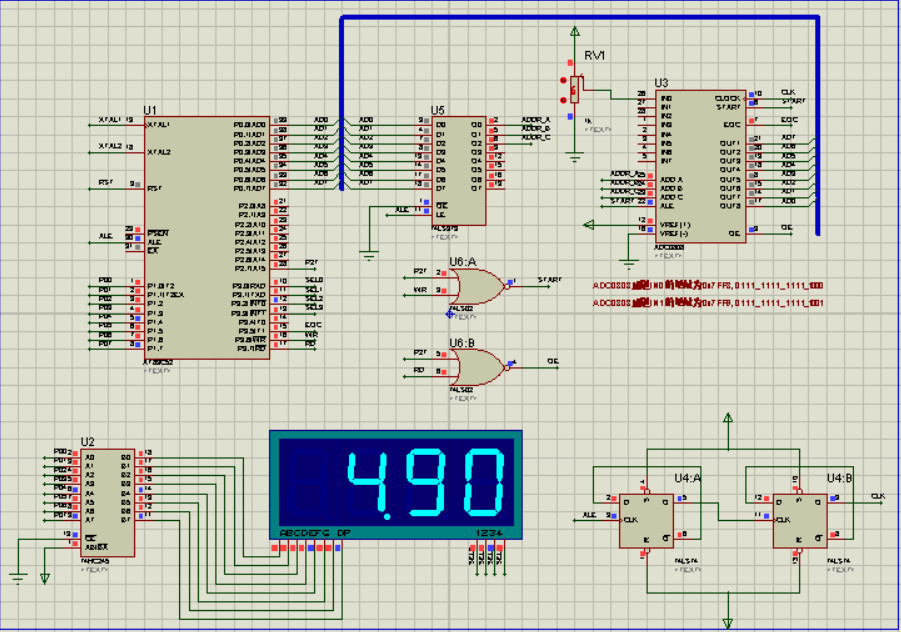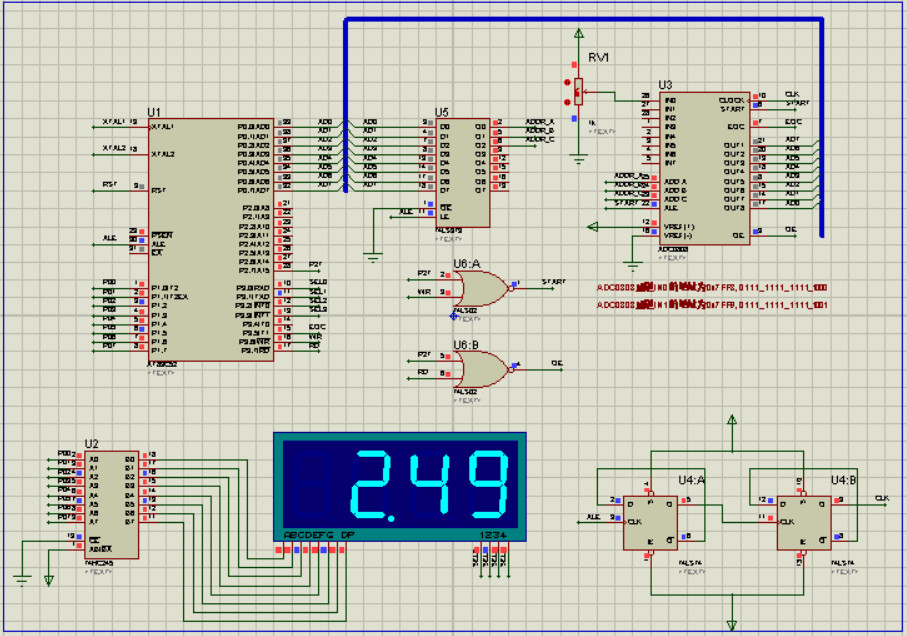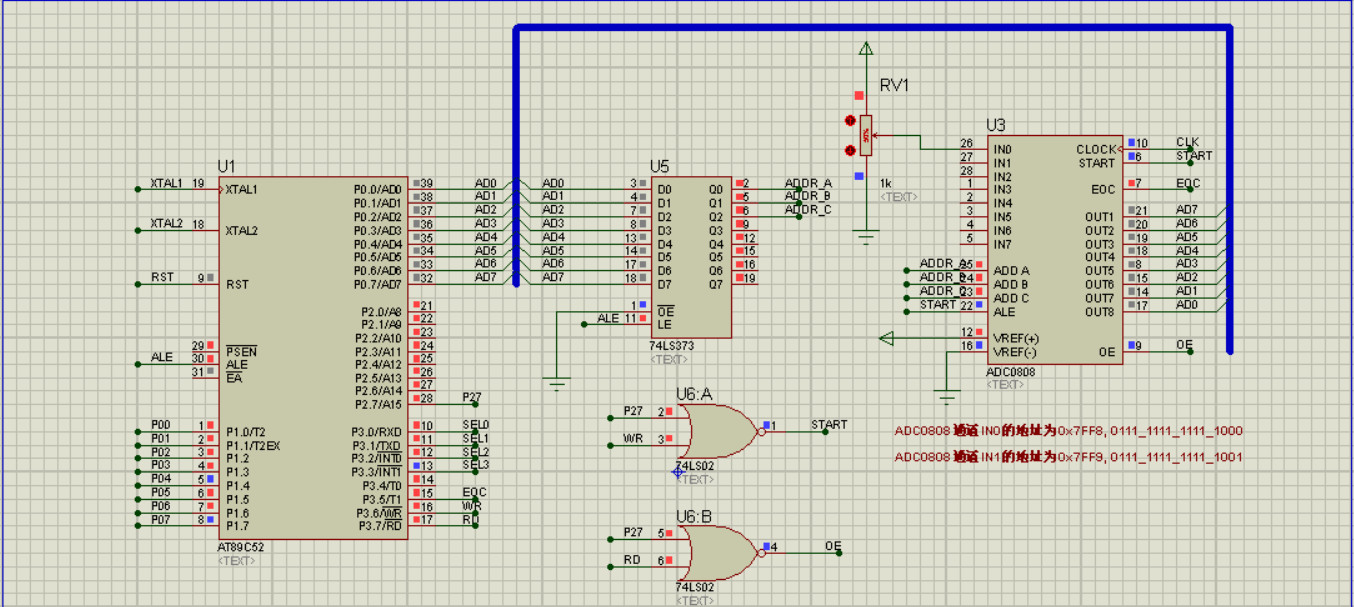1 实验现象


2 实验原理(略)
3 系统设计(略)
4 硬件设计


5 软件设计
5.1 主函数
#include "DisplaySmg.h"
#include "ADC0809.h"
#include "Timer0.h"
unsigned char adc_result = 0;
int adc_result_show = 0;
unsigned char adc_flag = 1; //启动ADC转换的标志信号
void disp_num() //将待显示数据放入缓存区
{
LedBuf[0]= 23; //千位,不显示
LedBuf[1]= adc_result_show/100; //百位
LedBuf[2]= adc_result_show/10%10; //十位
LedBuf[3]= adc_result_show%10; //个位
}
void main()
{
Timer0_Init(); //定时计数器T0初始化
EA=1; //中断总开关
DotDig1=1; //点亮第二个数码管的小数点
while(1)
{
adc_result = ADC0809_Conv(); //滤波处理,不能只采样一次,应该进行多次采样数字滤波
adc_result_show = adc_result*1.0*100*5/255; //数据变换处理(线性标度变换)
disp_num(); //显示数据
}
}
void Timer0_ISR(void) interrupt 1
{
static unsigned int timer0cnt=0;
TR0=0; //关闭定时器
timer0cnt++;
if(timer0cnt>=500)
{
timer0cnt = 0;
adc_flag = 1; //500ms的标志信号
}
DisplaySmg(); //每过1ms,刷新一次数码管显示函数
TL0 = 0x66; //设置定时初始值,定时1ms
TH0 = 0xFC; //设置定时初始值,定时1ms
TR0=1; //打开定时器
}
5.2 ADC0809转换函数(片外RAM,总线方式连接)
#ifndef __ADC0809_H__
#define __ADC0809_H__
#include
#include //含有宏定义的包含语句
#define ADC0809_IN0 XBYTE[0x7ff8] //地址定义语句
sbit EOC = P3^5;
unsigned char ADC0809_Conv();
#endif
#include "ADC0809.h"
unsigned char ADC0809_Conv()
{
unsigned char adc_result=0;
//选通道,启动ADC转换
ADC0809_IN0 = 0x0; //借助对端口地址执行写操作时序,来满足AD的操作时序
while(EOC==0); //等待ADC转换结束,EOC变为高电平
adc_result = ADC0809_IN0; ////借助对端口地址执行读操作时序,来满足AD的操作时序
return adc_result;
}
5.3 数码管动态显示函数(定时器刷新)
#ifndef __DisplaySmg_H__
#define __DisplaySmg_H__
#include
#define GPIO_SEG P1 //段选端
sbit SEL0 = P3^0;
sbit SEL1 = P3^1;
sbit SEL2 = P3^2;
sbit SEL3 = P3^3;
extern unsigned char LedBuf[]; //外部变量声明
extern unsigned char DotDig0,DotDig1,DotDig2,DotDig3;
void DisplaySmg(void);
#endif
#include "DisplaySmg.h"
unsigned char code LedData[]={ //共阴型数码管的段码表,字符,序号
0x3F, //"0",0
0x06, //"1",1
0x5B, //"2",2
0x4F, //"3",3
0x66, //"4",4
0x6D, //"5",5
0x7D, //"6",6
0x07, //"7",7
0x7F, //"8",8
0x6F, //"9",9
0x77, //"A",10
0x7C, //"B",11
0x39, //"C",12
0x5E, //"D",13
0x79, //"E",14
0x71, //"F",15
0x76, //"H",16
0x38, //"L",17
0x37, //"n",18
0x3E, //"u",19
0x73, //"P",20
0x5C, //"o",21
0x40, //"-",22
0x00, //熄灭 23
};
unsigned char DotDig0=0,DotDig1=0,DotDig2=0,DotDig3=0; //小数点控制位
unsigned char LedBuf[]={22,22,22,22}; //显示缓存区
void DisplaySmg() //四位数码管,考虑小数点
{
unsigned char i; //等价于 "static unsigned char i = 0;"
unsigned char temp;
switch(i)
{
case 0:
{
GPIO_SEG = 0x00; //消影
if(DotDig0==1) //小数点
{
temp = LedData[LedBuf[0]] | 0x80; //点亮小数点
}
else
{
temp = LedData[LedBuf[0]];
}
GPIO_SEG = temp; //段码
SEL0=0; SEL1=1; SEL2=1; SEL3=1; //位选
i++;
break;
}
case 1:
GPIO_SEG = 0x00;
if(DotDig1==1) //小数点
{
temp = LedData[LedBuf[1]] | 0x80;
}
else
{
temp = LedData[LedBuf[1]];
}
GPIO_SEG = temp;
SEL0=1; SEL1=0; SEL2=1; SEL3=1;
i++;
break;
case 2:
GPIO_SEG = 0x00;
if(DotDig2==1) //小数点
{
temp = LedData[LedBuf[2]] | 0x80;
}
else
{
temp = LedData[LedBuf[2]];
}
GPIO_SEG = temp;
SEL0=1; SEL1=1; SEL2=0; SEL3=1;
i++;
break;
case 3:
GPIO_SEG = 0x00;
if(DotDig3==1) //小数点
{
temp = LedData[LedBuf[3]] | 0x80;
}
else
{
temp = LedData[LedBuf[3]];
}
GPIO_SEG = temp;
SEL0=1; SEL1=1; SEL2=1; SEL3=0;
i=0;
break;
default:break;
}
}
5.4 定时器T0模块
#ifndef __Timer0_H__
#define __Timer0_H__
#include
void Timer0_Init(void);
#endif
#include "Timer0.h"
void Timer0_Init(void) //1毫秒@11.0592MHz
